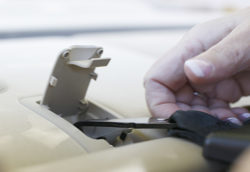At Safe Ride News Publications, our team has been busy researching, editing, and compiling the 2013 LATCH Manual. We are eager for its January publication, which will include many updates and new information.
As part of this process, I’ve spent much of the last few weeks reading CR owner’s manuals (a process that has been aided immeasurably by the SBS USA Child Restraint Manufacturer’s Instructions DVD). As always, this is fascinating reading and never ceases to turn up new insights about specific models.
I also have come across passages that leave me scratching my head, raising my eyebrows, or even groaning out loud. I don’t mean to be critical. I understand that writing a CR manual is a very difficult task, especially given the challenge to meet so many competing goals: make it simple, yet clear; keep it short, yet cover all important issues; use the right mix of graphics versus words.
For the LATCH Manual project, I’ve often read each manufacturer’s CR manuals in roughly chronological order. My general impression from that process is to applaud all CR manufacturers—the manuals have vastly improved over time (even as CR technology has become more complex). All of us who work with your products greatly appreciate your obvious efforts.
But, since I’m in the lucky position of having this soapbox and also grateful to know that many CR manufacturers are subscribers (and, I hope, readers), I do have one bone to pick, and that is in the way tether information is presented.
I will not name names, nor do I have to—this aspect of the information could be improved in nearly every manual I reviewed. The degree to which the presentation is lacking does, of course, vary. But, with various studies estimating tether usage from a dismal 50 percent to a downright depressing 29 percent, even if your coverage is currently adequate, shouldn’t more effort be made to make it outstanding?
So, I’d like to use this forum to call on CR instruction writers to pay extra attention to tethers when writing new manuals and upgrading current ones.
Here’s some advice that’s a little more concrete:
- Make sure tether information stands out. (Often, it seems like an afterthought.)
- Don’t relegate tether information to a section toward the end of the manual. (An interesting study would be to find out how many caregivers read this far!)
- When describing how to install a forward-facing CR with a seat belt, be sure to mention adding the tether. (Some manuals include this step only for LATCH installations.)
- If you have a forward-facing summary checklist (a helpful feature), be sure it includes adding the tether. (Some don’t!)
- Show tethers graphically with detailed drawings. (Some do not show the tether, and some that do are too basic and don’t include details, like the adjuster.)
- Don’t use the term LATCH when you actually mean only the lower attachments. Caregivers need to know that LATCH refers to both lower anchors AND tethers. We can’t expect the public to understand these concepts if we ourselves are inconsistent.
I know this sounds scolding, and I hope that all readers know that these observations are made constructively and with the utmost respect for manufacturers. Actually, although CR manuals set off this train of thought, I see this as an important point for ALL of us. We can all take on this challenge with respect to how we present tethers in our program materials, on our websites, and when talking with caregivers. I pledge to take my own advice as I go through updating SRN materials, like our Fact Sheets and presentation materials, for the coming year.
But, bottom line: As much as CPSTs might dream of being able to teach all caregivers, let’s face it—in the vast majority of cases, the educational process is a solo endeavor involving only the caregiver and a manual.
 —Denise Donaldson
—Denise Donaldson

